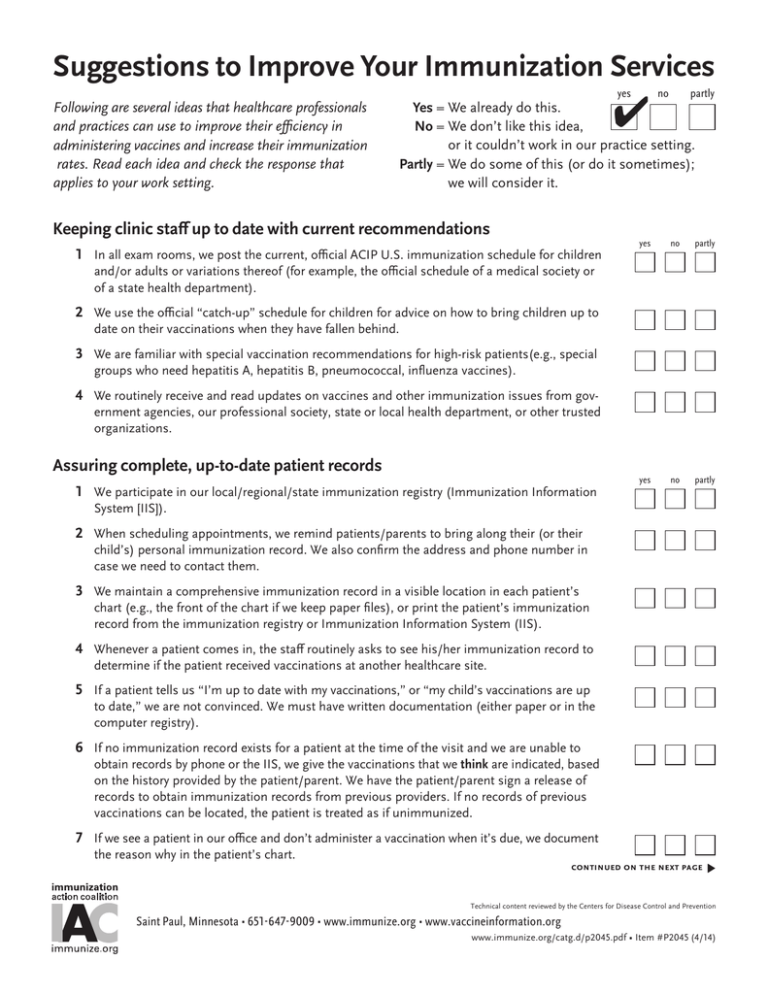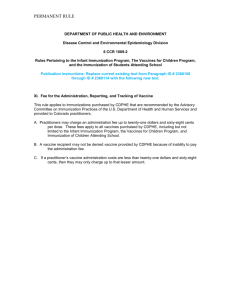Suggestions to Improve Your Immunization Services 1
advertisement

Suggestions to Improve Your Immunization Services Following are several ideas that healthcare professionals and practices can use to improve their efficiency in administering vaccines and increase their immunization rates. Read each idea and check the response that applies to your work setting. yes ✔ Keeping clinic staff up to date with current recommendations no partly Yes=We already do this. No=We don’t like this idea, or it couldn’t work in our practice setting. Partly=We do some of this (or do it sometimes); we will consider it. 1 In all exam rooms, we post the current, official ACIP U.S. immunization schedule for children yes no partly yes no partly and/or adults or variations thereof (for example, the official schedule of a medical society or of a state health department). 2We use the official “catch-up” schedule for children for advice on how to bring children up to date on their vaccinations when they have fallen behind. 3We are familiar with special vaccination recommendations for high-risk patients(e.g., special groups who need hepatitis A, hepatitis B, pneumo­coccal, influenza vaccines). 4We routinely receive and read updates on vaccines and other immunization issues from government agencies, our professional society, state or local health department, or other trusted organizations. Assuring complete, up-to-date patient records 1We participate in our local/regional/state immunization registry (Immunization Information System [IIS]). 2When scheduling appointments, we remind patients/parents to bring along their (or their child’s) personal immunization record. We also confirm the address and phone number in case we need to contact them. 3We maintain a comprehensive immunization record in a visible location in each patient’s chart (e.g., the front of the chart if we keep paper files), or print the patient’s immunization record from the immunization registry or Immunization Information System (IIS). 4Whenever a patient comes in, the staff routinely asks to see his/her immunization record to determine if the patient received vaccinations at another healthcare site. 5If a patient tells us “I’m up to date with my vaccinations,” or “my child’s vaccinations are up to date,” we are not convinced. We must have written documentation (either paper or in the computer registry). 6If no immunization record exists for a patient at the time of the visit and we are unable to obtain records by phone or the IIS, we give the vaccinations that we think are indicated, based on the history provided by the patient/parent. We have the patient/parent sign a release of records to obtain immunization records from previous providers. If no records of previous vaccinations can be located, the patient is treated as if unimmunized. 7If we see a patient in our office and don’t administer a vaccination when it’s due, we document the reason why in the patient’s chart. continued on the next page � Technical content reviewed by the Centers for Disease Control and Prevention Saint Paul, Minnesota • 651- 647- 9009 • www.immunize.org • www.vaccineinformation.org www.immunize.org/catg.d/p2045.pdf • Item #P2045 (4/14) Suggestions to Improve Your Immunization Services (continued) page 2 of 3 Assuring complete, up-to-date patient records (continued from page 1) 8If we have written confirmation that a patient received vaccines at another site or at a public yes no partly yes no partly yes no partly yes no partly health, school-based, worksite-based, or community-based immunization site, we update the patient’s medical chart or the IIS with that information, recording the vaccination date(s) and healthcare site(s) where the vaccination was received. 9With each patient visit, we document on the patient’s chart that their immunization status has been reviewed (e.g., a notation such as “immunization status reviewed” is pre-printed on the progress note or other chart form). Maintaining and protecting our vaccine supply 1We have a designated vaccine coordinator and a designated backup coordinator who oversee all vaccine storage and handling activities. 2We provide vaccine storage and handling training to all new staff and to all staff whenever recommendations are changed or new product added. Getting patients ready for their vaccinations 1We’ve trained our nursing and office staff (e.g., receptionist, scheduler) to know how to determine valid and invalid contraindications to vaccinations, as well as the minimum ages and minimum intervals permissible between vaccinations. Guides to valid contraindications and precautions, and minimum age and interval charts are posted or easily available to all staff. This training ensures that our clinic staff miss no opportunity to vaccinate. 2We ask patients/parents to complete a simple screening questionnaire for contraindications to determine if the vaccinations they need can be given safely on the day of their visit. To save time, we have them complete it prior to seeing the clinician (e.g., in the waiting room or exam room). 3Before the clinician sees the patient, a staff member completes an immunization assessment and gives Vaccine Information Statements (VISs) to the patient/parent to read. If they need a VIS in another language, we give it, if it is available. Avoiding “missed opportunities” 1Our staff are trained to administer multiple vaccinations to patients who are due for multiple vaccinations. 2Prior to patient visits, we review the immunization record for each patient and flag charts of those who are due or overdue. 3If children in our waiting room are the siblings or children of the patient, we pull their charts and review their immunization status and vaccinate them if needed before they leave the office. 4We have immunization “champion(s)” in our clinic to keep all clinic staff up-to-date on current recommendations and effective strategies to avoid missed opportunities. 5Vaccines are consistently available (system is in place to order vaccines in a timely manner). continued on the next page � Technical content reviewed by the Centers for Disease Control and Prevention Saint Paul, Minnesota • 651- 647- 9009 • www.immunize.org • www.vaccineinformation.org www.immunize.org/catg.d/p2045.pdf • Item #P2045 (4/14) Suggestions to Improve Your Immunization Services (continued) page 3 of 3 Improving access to clinic services 1We provide vaccination services during some evening and/or weekend hours. 2Patients can walk in during office hours for a “nurse only” visit and get vaccinated. We use yes no partly yes no partly yes no partly standing orders. 3Our nurses can give vaccinations under standing orders (i.e., they can independently screen patients and administer vaccines under pre-existing signed physician’s orders). 4We use all patient encounters (including acute-care and follow-up visits) to assess and provide vaccinations. 5If children miss “well-child” visits and can’t be rescheduled quickly, we reschedule them in one to two weeks for a “shots only” visit. Communicating with patients 1We give patients/parents a simple schedule of recommended vaccinations. 2We give patients/parents an information sheet about how to treat pain and fever following vaccinations. 3We always update the patient’s personal immunization record card each time we administer vaccinations. If the patient doesn’t have a card, we give them one that contains their vacci­ nation history. 4We provide resources (e.g., information, pamphlets, websites, hotline numbers) to patients/ parents who have questions or concerns about vaccine safety or who want more vaccine information. We provide translated materials, if available. 5When giving vaccinations, we inform the patient/parent when the next appointment for vaccinations is due. We schedule the visit before they leave the office if our appointment system allows it; otherwise we put the information in a manual tickler system or electronic recall system. 6We contact all patients who are due for vaccinations with a reminder (e.g., by phone or mail) and those who are past due with a recall (e.g., using computerized tracking or a simple tickler system). 7We provide or refer our vaccine-hesitant patients to reliable resources to help in their decisionmaking. If they refuse a vaccine, we have them sign a declination form. We revisit the issue in the future. Evaluating and improving our clinic’s performance 1We routinely assess immunization levels of our patient population, including those with high- risk indicators. (Contact your state or local health department’s immunization staff for assistance in performing such an assessment.) We share this information with all our staff and use it to develop strategies to improve immunization rates. 2We are enrolled in the Vaccines for Children (VFC) program so that we can provide free vaccine to uninsured children ( 0 –18 years) and others who are eligible under the state’s program. Technical content reviewed by the Centers for Disease Control and Prevention Saint Paul, Minnesota • 651- 647- 9009 • www.immunize.org • www.vaccineinformation.org www.immunize.org/catg.d/p2045.pdf • Item #P2045 (4/14)

